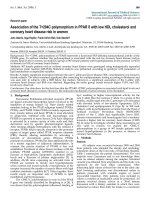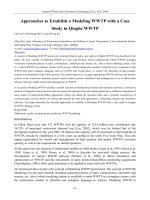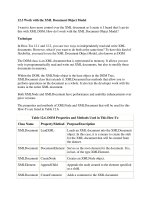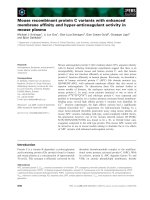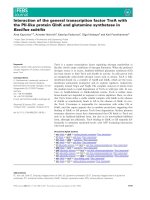Forecasting energy intensity with fourier residual modified grey model An empirical study in Taiwan
Bạn đang xem bản rút gọn của tài liệu. Xem và tải ngay bản đầy đủ của tài liệu tại đây (332.69 KB, 6 trang )
FORECASTING ENERGY INTENSITY WITH FOURIER RESIDUAL
MODIFIED GREY MODEL: AN EMPIRICAL STUDY IN TAIWAN
Thanh-Lam Nguyen, Ying-Fang Huang
National Kaohsiung University of Applied Sciences, Kaohsiung 80778, Taiwan
ABSTRACT: Energy intensity is defined as the energy consumption for producing every
unit of real GDP in a certain time frame. Studies in forecasting the energy intensity have not
well positioned due to the difficulty in collecting relevant data on the determinants affecting
the energy consumption and GDP. Therefore, in this study, it is proposed to use the Grey
forecasting model GM(1,1) to predict the energy consumption and real GDP before the
intensity is forecasted. To enhance the accuracy level of the forecasting models, their
residuals are then modified with Fourier series. In the case of Taiwan, the modified models
resulted in very low values of mean of absolute percentage error (MAPE) of 0.33% and
0.58%, respectively to the energy consumption and real GDP. Hence, the modified model is
strongly suggested to forecast the energy intensity in Taiwan from 2012-2015.
Keywords: GM(1,1), FGM(1,1), Grey forecasting, Fourier series, Energy intensity.
I. INTRODUCTION
Energy is the core of most economic,
environmental and developmental issues
around the globe. It has been well proved
that there is a close relationship between
the energy consumption and economic
development. As per the definition offered
by the Department of Economic and Social
Affairs of the United Nations Secretariat,
energy intensity is defined as the energy
consumption for producing every unit of
real GDP in a certain time frame which
means that the lower the energy intensity of
an economy is, the better the economy
performs. Energy intensity indicates the
total energy used to support a wide range of
production and consumption (economic and
social) activities [1]. Therefore, it is usually
considered as one of the measures of
sustainable development. A country with
highly economical productivity, pleasant
weather, geographically well-allocated
work places, fuel efficient vehicles, mass
transportation, etc., will have a far lower
energy intensity and vice versa.
Many researches have been conducted
and it has been found out that energy
consumption and GDP are positively
correlated though the correlation
coefficients may be different from country
to country [2]. Changes in the economy
structure may result in using less additional
energy; however, total energy consumption
is still increasing [3]. In reducing the
emissions through reducing the energy
consumption, it was pointed out that the
developed countries tend to be more
affected by such policy rather than
developing ones [4].
Many different researchers [5-15] have
focused on the analysis of the relationship
between the energy consumption and GDP.
Nevertheless, the number of studies in
forecasting the energy intensity is actually
limited due to the fact that collecting
relevant data on the determinants affecting
the energy consumption and GDP runs into
a lot of difficulties. Therefore, in this study,
it is proposed to use the conventional Grey
forecasting model GM(1,1), which has
been widely used in different areas due to
its ability to deal with the problems of
uncertainty with few data points and/or
“partial known, partial unknown”
information, to predict the energy
consumption and real GDP before the
intensity is forecasted. To enhance the
accuracy level of the forecasting model, its
residuals are then modified with Fourier
series. An empirical study in Taiwan is
investigated as an example for this
improved model.
II. LITERATURE REVIEWS
2.1 Grey Model
Grey theory offers a new approach to
deal mainly with the problems of
uncertainty with few data points and/or
poor information which is said to be
“partial known, partial unknown” [16]. The
core of Grey theory is the Grey dynamic
model which is usually called Grey model
(GM). The Grey model is used to execute
the short-term forecasting operation with
no strict hypothesis for the distribution of
the original data series [17]. The general
GM model has the form of GM(d,v), where
d is the rank of differential equation and v
is the number of variables appeared in the
equation. The basic model of Grey model is
GM(1,1), a first-order differential model
with one input variable. The procedure to
obtain GM(1,1) is as the following:
Step 1: Suppose an original series with n
entries is
(0)
x
:
(0) (0) (0) (0)
(1), , ( ), ( )x x x k x n
1
where
(0)
()xk
is the value at time k
1,kn
.
Step 2: From the original series
(0)
x
, a new
series
(1)
x
can be generated by one time
accumulated generating operation (1-
AGO), which is
(1) (1) (1) (1)
(1), , ( ), , ( )x x x k x n
2
where
(1) (0)
1
( ) ( )
k
j
x k x j
Step 3: A first-order differential equation
with one variable is expressed as:
(1)
(1)
dx
ax b
dt
3
where a is called a developing coefficient
and b is called a grey input coefficient.
These two coefficients can be determined
by the least square method as shown
below:
1
,
T
TT
a b B B B Y
4
where
(1) (1)
(1) (1)
(1) (1)
(1) (2) / 2
1
(2) (3) / 2
1
1
( 1) ( ) / 2
xx
xx
B
x n x n
(0) (0) (0)
(2), (3), , ( )
T
Y x x x n
Therefore, the solution of equation (3) is
expressed as:
(1) (1)
1
at
bb
x t x e
aa
5
Equation (5) is also known as time
response function of the equation (3). From
equation (5), the time response function of
the GM(1,1) is given by:
1
(1) (0)
ˆ
1
1,
ak
bb
x k x e
aa
kn
6
Based on the operation of one time
inverse accumulated generating operation
(1-IAGO), the predicted series
(0)
ˆ
x
can be
obtained as the following:
(0) (0) (0) (0)
ˆ ˆ ˆ ˆ
1 , , , ,x x x k x n
7
where
(0) (1)
(0) (1) (1)
ˆˆ
(1) (1)
ˆ ˆ ˆ
1 2,
xx
x k x k x k k n
2.2 Fourier Residual Modification
In order to improve the accuracy of
forecasting models, the Fourier series has
been widely and successfully applied in
modifying the residuals in Grey forecasting
model GM(1,1) which reduces the values
of RMSE, MAE, MAPE, etc., [18-22]. The
overall procedure to obtain the modified
model is as the followings:
Let
x
is the orginal series of n entries
and
ˆ
x
is the predicted series obtained from
GM(1,1). Based on the predicted series
ˆ
x
,
a residual series named
is defined as:
2 , 3 , 4 , , , ,kn
8
where
ˆ
( ) ( ) ( ) 2,k x k x k k n
Expressed in Fourier series,
k
is
rewritten as:
0
1
1
cos sin
2
F
ii
i
k a a D b D
9
where
2 / ( 1)D ik n
2,kn
where
1 / 2 1Fn
called the
minimum deployment frequency of Fourier
series [21] and only take integer number
[18-20].
And therefore, the residual series is
rewritten as:
.PC
10
where
1 2 1 2 1 2 2
cos 2 sin 2 cos 2 sin 2
2 1 1 1 1
1 2 1 2 1 2 2
cos 3 sin 3 cos 3 sin
2 1 1 1
1 2 1 2 1 2
cos sin cos
2 1 1 1
FF
n n n n
F
n n n
P
F
n n n
n n n
3
1
2
sin
1
F
n
F
n
n
0 1 1 2 2
, , , , , , ,
T
FF
C a a b a b a b
The parameters
0 1 1 2 2
, , , , , , ,
FF
a a b a b a b
are
obtained by using the ordinary least
squares method (OLS) which results in the
equation of:
1
T
TT
C P P P
Once the parameters are calculated, the
modified residual series
ˆ
is then achieved
based on the following expression:
0
1
1
ˆ
cos sin
2
F
ii
i
k a a D b D
11
From the predicted series
ˆ
x
and
ˆ
, the
Fourier modified series
x
of series
ˆ
x
is
determined by:
1 , 2 , , , ,x x x x k x n
12
where
ˆ
11
ˆ
ˆ
2,
xx
x k x k k k n
To evaluate the model accuracy, there
are four important indexes to be
considered, such as:
The mean absolute percentage error
(MAPE) [19, 22, 23]:
1
1 ( ) ( )
1,
()
n
k
x k v k
MAPE k n
n x k
where v(k) is the forecasted value of kth
entry from the model (
ˆ
( ) ( )v k x k
in
GM(1,1) or
( ) ( )v k x k
in FGM(1,1)).
The post-error ratio C [24, 25]:
2
1
S
C
S
where
2
1
11
11
( ) ( )
nn
kk
S x k x x x k
nn
2
2
1
1
1
()
1
( ) ( ) ( ) ( )
n
k
n
k
Sk
n
k x k v k k
n
The smaller the C value is, the higher
accuracy the model has.
The small error probability P [24, 25]:
1
0.6745
k
Pp
S
The higher the P value is, the higher
accuracy the model has.
The forecasting accuracy
[25]:
1 MAPE
The above four indexes are used to classify
the grades of forecasting accuracy as in
Table 1.
Table 1. Four grades of forecasting accuracy
Grade level
MAPE
C
P
I (Excellent)
< 0.01
< 0.35
> 0.95
> 0.95
II (Good)
< 0.05
< 0.50
> 0.80
> 0.90
III (Qualified)
< 0.10
< 0.65
> 0.70
> 0.85
IV (Unqualified)
≥ 0.10
≥ 0.65
≤ 0.70
≤ 0.85
III. EMPIRICAL RESULTS
The data of energy consumption from
1999 – 2011 in Taiwan are obtained from
the Bureau of Energy of Ministry of
Economic Affairs of Taiwan [26]; whereas
the data of the Taiwan GDP from the same
period are collected from International
Monetary Fund [27]. Only data from 1999-
2010 are used to build relevant GM(1,1)
and FGM(1,1) models. The data in 2011 is
used to compare with the forecasted value
from the selected model to further affirm its
forecasting power.
3.1. Forecasting model for the energy
consumption
Based on the algorithm expressed in
section 2.1, the fundamental Grey
forecasting model for the energy
consumption named GM(1,1)
E
is found as
the following:
(1) 0.030273( 1)
ˆ
( ) 3377369.76 3285397.26
k
x k e
The residual series attained from GM(1,1)
E
is then modified with Fourier series, which
results in the modified model FGM(1,1)
E
as
per the algorithm stated in section 2.2. The
evaluation indexes of GM(1,1)
E
and
FGM(1,1)
E
are summarized as in Table 2.
Table 2 clearly showed that between
GM(1,1)
E
and FGM(1,1)
E
, FGM(1,1)
E
is
selected because it has a lower value of
MAPE and a better forecasting power. So,
FGM(1,1)
E
is used to forecast the energy
consumption in 2011. The forecasted value
is then compared with the actual
consumption in order to further affirm its
forecasting power as shown in Table 3. The
MAPE value of 5.55% indicates that
FGM(1,1)
E
can be appropriately used to
forecast the consumption in 2012 – 2015.
The forecasted values in this period are
shown in Table 4.
3.2. Forecasting model for the GDP
Similarly, the fundamental Grey
forecasting model for the GDP named
GM(1,1)
G
is found as the following:
(1) 0.032091( 1)
ˆ
( ) 8943.01 8667.89
k
x k e
FGM(1,1)
G
is accordingly obtained
based on section 2.2. It is also selected
because it outperforms GM(1,1)
G
in term of
low MAPE value as shown in Table 2. Its
forecasted value of GDP in 2011 shown in
Table 3 has an MAPE value of 1.83%
indicating that it can be used to forecast the
GDP in 2012 – 2015. Its relevant forecasted
values are also shown in Table 4.
Table 2. Summary of evaluation indexes of model accuracy
Index
Model
MAPE
S1
S2
C
P
Forecasting
power
GM(1,1)
E
0.0352
14781.86
5032.84
0.34
1.00
0.9648
Good
FGM(1,1)
E
0.0033
14781.86
475.76
0.03
1.00
0.9967
Excellent
GM(1,1)
G
0.0414
42.22
15.94
0.38
1.00
0.9586
Good
FGM(1,1)
G
0.0058
42.22
2.31
0.05
1.00
0.9942
Excellent
Table 3. Forecasted energy consumption and GDP in 2011
Model
Unit
Actual value
Forecasted value
MAPE
FGM(1,1)
E
10
3
KLOE
131,832.50
139148.40
0.0555
FGM(1,1)
G
10
9
USD
430.58
422.71
0.0183
Table 4. Forecasted energy consumption and GDP from 2012-2015
Item
Unit
2012
2013
2014
2015
Energy
10
3
KLOE
148519.70
147592.90
152744.00
157530.00
GDP
10
9
USD
447.45
454.54
465.26
479.98
Energy intensity
KLOE/10
6
USD
331.92
324.71
328.30
328.20
Table 4 shows that there is a small
decrease in the energy intensity index of
Taiwan in the coming years. This could be
explained as an outcome of the past and
current investment in the new production
technology as well as the modern facilities
in the transportation, services and
residential sectors. Besides, the moving of
its manufacturing factories to other
countries including China, Vietnam,
Indonesia, Malaysia, Laos, Thailand, etc.,
as well as the enhancing of its service
industries make Taiwan not only consume
less energy but also produce higher GDP,
which significantly contribute to the
decrease of the energy intensity index of
Taiwan.
IV. CONCLUSION
The accuracy level of the traditional Grey
forecasting model GM(1,1) can be well
improved if the model is modified with
Fourier series. In the case of energy
intensity of Taiwan, with the Fourier
modified Grey forecasting model
FGM(1,1), it was found out that the energy
intensity of Taiwan becomes lower and
lower representing a better & stable
development of the country. This result
plays as an excellent motivation for the
authorities to assert that they are on the
right way to develop Taiwan in general and
its economy in particular. Other countries
could refer to this as a good example to
focus on research & development as well as
invest and apply advanced technology in
most of their activities.
REFERENCES
[1] Department of Economic and Social
Affairs of the United Nations
Secretariat, Indicators of sustainable
development: Guidelines and
Methodologies, 3
rd
Edition, pp.87,
United Nations, New York, 2007.
[2] R. Hannesson, Energy and GDP
growth, International Journal of
Energy Sector Management, Vol. 3,
Issue 2, 2009, pp.157 – 170.
[3] European Environmental Agency,
Total primary energy intensity (CSI
028/ENER 017), EEA, 2006.
[4] J. Chontanawat, L. C. Hunt and R.
Pierse, Casuality between energy
consumption and GDP: Evidence
from 30 OECD and 78 Non-OECD
countries, Surrey Energy Economics
Centre (SEEC), University of Surrey,
United Kingdom, 2006, pp.4.
[5] D. I. Stern, A multivariate
Cointegration Analysis of the role of
the energy in US, Energy Economics,
Vol. 22, 2000, pp.267 – 283.
[6] F. Climent and A. Pardo, Decoupling
factors on the energy-output linkage:
The Spanish case, Energy Policy,
Vol. 35, 2007, pp.522 – 528.
[7] K. Ghali and M. El-Sakka, Energy
use and output growth in Canada: A
multivariate Cointegration analysis,
Energy Economics, Vol. 26, 2004,
pp.225 – 238.
[8] U. Soytas and R. Sari, The
relationship between energy and
production: Evidence from Turkish
manufacturing industry, Energy
Economics, Vol. 29, pp.1151 – 1165.
[9] B. S. Warr and R. U. Ayres, Evidence
of causality between the quantity and
quality of energy consumption and
economic growth, Energy, Vol. 35,
2010, pp.1688 – 1693.
[10] C. Lee and C. Chang, Structural
breaks, energy consumption, and
economic growth revisited: Evidence
from Taiwan, Energy Economics,
Vol. 27, 2005, pp.857 – 872.
[11] J. E. Payne, US disaggregate fossil
fuel consumption and real GDP: An
empirical note, Energy Sources, Part
B: Economics, Planning and Policy,
Vol. 6, 2011, pp.63 – 68.
[12] J. Asafu-Adjaye, The relationship
between energy consumption, energy
prices and economic growth: Time
series evidence from Asian
developing countries, Energy
Economics, Vol. 22, 2000, pp.615 –
625.
[13] K. Fatai, L. Oxley and F. G.
Scrimgeour, Modelling the causal
relationship between energy
consumption and GDP in New
Zealand, Australia, India, Indonesia,
Philipines, and Thailand,
Mathematics and Computers in
Simulation, Vol. 64, 2004, pp.431 –
445.
[14] F. Climent and A. Pardo, Decoupling
factors on the energy-output linkage:
The Spanish case, Energy Policy,
Vol. 35, 2007, pp.522 – 528.
[15] J. L. Hu and C. H. Lin, Disaggregated
energy consumption and GDP in
Taiwan: A threshold co-integration
analysis, Energy Economics, Vol. 30,
2008, pp.2342 – 2358.
[16] S. F. Liu, Advances in Grey system
theory and its applications,
Proceedings of 2007 IEEE
International Conference on Grey
Systems and Intelligent Services,
China, 2007, pp.1 – 6.
[17] S. J. Wang, W. L. Wang, C. T. Huang
and S. C. Chen, Improving inventory
effectiveness in RFID-enabled global
supply chain with Grey forecasting
model, Journal of Strategic
Information Systems, Vol. 20, 2011,
pp.307 – 322.
[18] M. Askari and A. Fetanat, Long-term
load forecasting in power system:
Grey system prediction-based models,
Journal of Applied Sciences, Vol. 11,
2011, pp.3034 – 3038.
[19] Z. Guo, X. Song and J. Ye, A
Verhulst model on time series error
corrected for port throughput
forecasting, Journal of the Eastern
Asia Society for Transportation
Studies, Vol. 6, 2005, pp.881 – 891.
[20] L.C. Hsu, Applying the grey
prediction model to the global
integrated circuit industry,
Technological Forecasting and Social
Change, Vol. 70, 2003, pp.563 – 574.
[21] Y. L. Huang and Y. H. Lee,
Accurately forecasting model for the
Stochastic Volatility data in tourism
demand, Modern Economy, Vol. 2,
2011, pp.823 – 829.
[22] M.L. Kan, Y. B. Lee and W. C. Chen,
Apply grey prediction in the number
of Tourist, The 4
th
international
conference on Genetic and
Evolutionary Computing, 2010,
pp.481 – 484.
[23] C. C. Hsu and C. Y. Chen,
Applications of improved grey
prediction model for power demand
forecasting, Energy Conversion and
Management, Vol. 44, 2003, pp.2241
– 2249.
[24] J. Hua and Q. Liang, Application
research of the Grey forecast in the
Logistics demand forecast, First
international workshop on Education
Technology and Computer Science,
2009, pp. 361 – 363.
[25] H. Ma and Z. Zhang, Grey prediction
with Markov-Chain for Crude oil
production and consumption in
China, Advances in Intelligent and
Soft Computing, Vol. 56, 2009,
pp.551 – 561.
[26] Bureau of Energy of Ministry of
Economic Affairs of Taiwan, Energy
Statistics. Retrieved on April 15,
2012 from www.moeaboe.gov.tw/English/
Statistics/EnStatistics.aspx
[27] International Monetary Fund, Country
information. Retrieved on April 20,
2012 from www.tradingeconomics.com/
taiwan/gdp
Corresponding author:
Thanh-Lam Nguyen
Graduate Institute of Mechanical and
Precision Engineering, National Kaohsiung
University of Applied Sciences
415, Chien Kung Rd., Kaohsiung 80778,
Taiwan, R.O.C.
Email:
